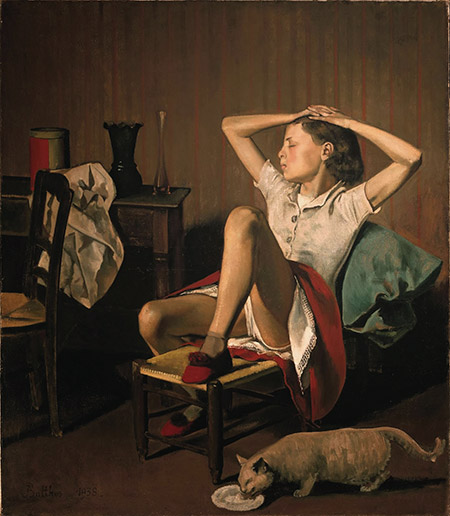
Originally published on metropolis.co.jp on May 2014

The Polish-French painter Balthus is one of those artists surrounded by an aura of suave depravity and urbane notoriety. Indeed, one of the functions of art has always been to act as a justifying filter for tastes and proclivities that are not otherwise entirely acceptable, but which may be “excused” under the umbrella of “art.”
Balthus (or Balthasar Klossowski de Rola, to give him his full, slightly demonic-sounding name) can be seen in these terms because his art, which often features underage girls in erotic situations, has earned him, if not the reputation of an out-and-out pedophile, at least that of someone who has channelled certain Lolita complexes.
Indeed, the controversy surrounding his art has probably been strengthened in recent years as new forms of moral outrage develop in the wake of the various “sexual liberations” that have taken place in recent decades. Recently, an exhibition of the artist’s Polaroids, featuring a young model who posed for him from the age of eight to 16, was canceled in Germany after accusations of pedophilia.
It is interesting to consider, therefore, how Japan, a country notorious for its own “Lolicon,” will take to the major retrospective of the artist’s work that opened recently at the Tokyo Metropolitan Museum of Art.
The exhibition plays it reasonably safe by not including Balthus’ more explicit works—like Guitar Lesson (1934), which shows an older woman fingering the pudendum of an underage girl—and instead goes for images that allow any dark thoughts to be deflected back onto those who think them.
A case in point is Thérèse Dreaming (1938), a painting of a girl who was 12 at the time. The way that the artist invites us to look at the young girl’s panties through her arched leg seems rather obvious, but at the same time there is an element of deniability and an air of innocence as if the pose was just an “accident.”
This painting is also notable for a cat, a totemic animal for Balthus that the curators have interpreted as representing the artist himself. Interestingly, a few years ago the curators of an exhibition of École Japonaise de Paris painter Tsuguharu Foujita’s works made exactly the same interpretation.
If Balthus is the cat, then in Study for Nude and Cat (1949), a work in crayon, he is getting quite intimate with yet another young Lolita. The Cat at the Mediterranean (1949) seems to add credence to the identification, presenting a very anthropomorphized feline who seems to be enjoying the lifestyle of a successful artist.
The lightheartedness of works like this suggests that instead of—or besides—a Lolita complex, Balthus had a certain playfulness of mind that may have provided a more innocent basis for his affinity with the younger generation.
And yet for someone interested in the younger members of the female sex, Balthus certainly hit the jackpot when he came to Japan as a cultural ambassador in the 1960s. Here he met his second wife Setsuko, who was 35 years younger than him.
In addition to some pretty sketches of her, his encounter with Japan inspired some of the odder works on display, like Japanese Girl with Red Table (1967). In this work, with its quaint, archaic Japanese style, a disrobing female figure stalks across the floor in an almost feline way—hinting once again at the importance of pussies in the art of Balthus.
Tokyo Metropolitan Museum of Art, until Jun 22.







